The Popcorn Maker — An American Technology’s Journey to East Asia
Written by Xiaomeng Liu
Published on 15/12/2020
In May 2013, the beloved Australian-American science and entertainment show MythBusters released an episode called “How to Make Instant Popcorn.” The four-minute episode began with the show’s three presenters unveiling a — “made-in-China” — gourd-shaped cast-iron machine that “purports to be the very fastest-ever method for cooking popcorn.” On one side of the machine was a pressure gauge, and the cooking process was quite dramatic: one of the presenters put on a full bomb suit and carefully spit roasted the machine over an open gas burner, while the other two hid behind a safety shield. As the pressure gauge showed the interior having reached 1 MPa, the machine was set upright (with its lid toward the ceiling), and a lever on the machine was struck with a hammer to release the lid. A loud zap was heard, and, within a “fraction of a second” popcorn came blasting out of the machine, raining all over the floor.[1]
The intention of the particular MythBusters episode was to debunk the popcorn machine’s claim to be the “fastest” way to make popcorn. For comparison, the presenters first used less than two minutes to make popcorn in a frying pan, and the popcorn machine needed more than four. Nevertheless, while the show busted one myth it left another question dangling: though this particular machine was made in China, did the design itself also originate from the Chinese?
To those who grew up in mainland China during the 1980s and 1990s, the machine indeed looks familiar. One viewer commented: “I’m amazed that there should even be any doubt that the machine was invented in China — I mean, many of us Chinese did grow up with the device. We used to see old men operating them outside the school gate all the time.”
Like this viewer, however, many Chinese would be surprised to learn that these machines were, in fact, not a Chinese invention — the fact that they were not exclusive to China, that they were also seen in other places in East Asia might have provided the first clue. A Korean viewer commented: “We also have these in Korea to make rice puffs,” and a Taiwanese echoed a similar claim about Taiwan.
If the puffing machine did not originate from China, then where and when was it invented? Additionally, why was it (and perhaps still is in some places today) so popular in East Asian countries?
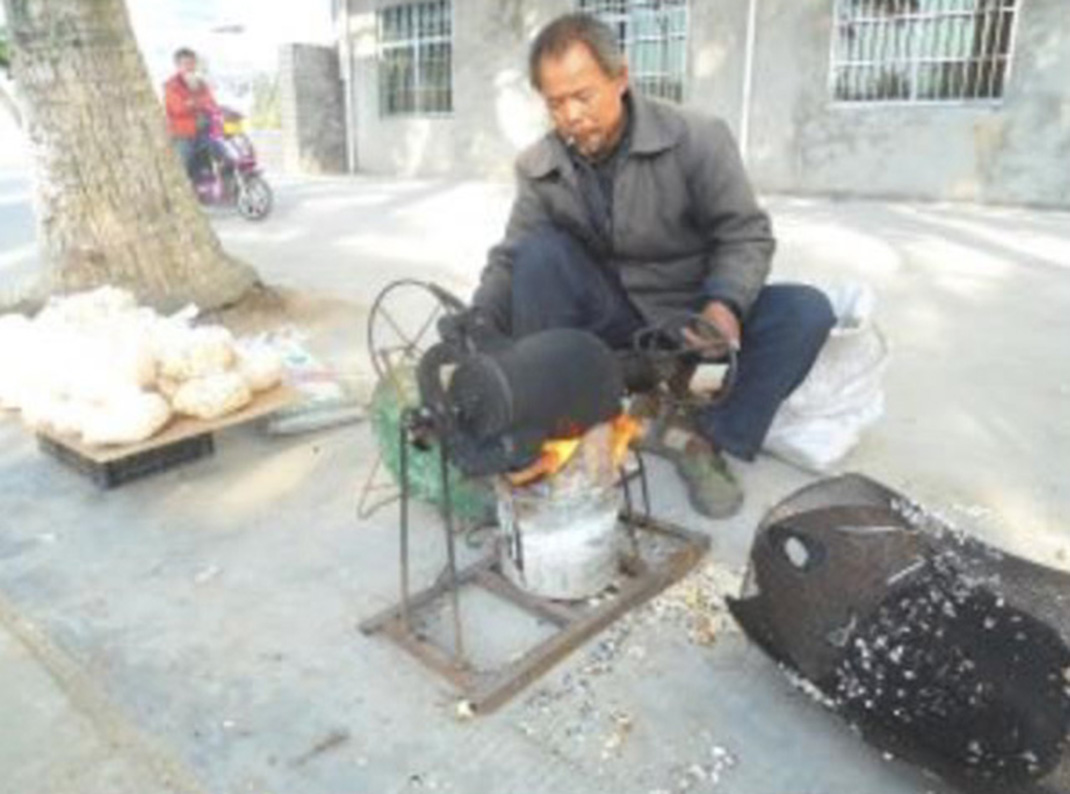
Shot from a Gun: The Origin of the Puffing Machine
The best-known commercial popcorn maker, the popcorn wagon, was first invented in 1885 by Charles Cretors in Chicago, but it looked nothing like the puffing machines subsequently seen in China. As it turns out, around 1904, the Quaker Oats Company in the U.S. began using puffing machines (this is the same Quaker Oats Company that sells numerous lines of breakfast oatmeal, cereals and other foods today). The puffing machine itself had been invented by an American called Alexander Pierce Anderson (1862 – 1943). Anderson was a botanist at the New York Botanical Garden, and, in 1901, he was conducting experiments to determine the moisture content inside starch crystals by heating the corn starch inside a sealed glass tube (his initial intention was not to devise a machine for the food industry at all). As the corn starch began to brown, Anderson struck the glass tube with a hammer which caused the tube to explode. As he saw, the starch that blasted out of the tube had turned into what he described as a “porous puffed mass, white as snow,” and had expanded to ten times its original size. Anderson would go on to experiment with different grains and finally invented a grain puffing device, which he revealed at the 1904 World’s Fair in St. Louis.
To most modern readers, the scientific principle that underlies Anderson’s invention is straightforward: when heated inside a sealed vessel, the moisture in each kernel of grain becomes superheated steam, which then blasts and bloats the kernel into a soft puff, and pressure builds up inside the vessel. When the vessel’s seal is broken, the pressure inside will drive the puffs out of the vessel. Anderson called his invention a “puffing gun.”
At the 1904 St. Louis World’s Fair, Anderson actually used eight of these bronze puffing guns to make puffed rice, rather than popcorn. This choice of grain was deliberate — he not only wanted to debut a new technology but also a new kind of food. Up until that point, Anderson had been working under the support of the Minneapolis Steel and Machinery Company, who sold its share of the invention to the Quaker Oats Company. This gave Anderson a chance to turn the machine into a commercial success, and he sealed the deal by putting on a great show at the World’s Fair. The rest — receiving full support from Quaker and having puffed rice and wheat branded as breakfast cereals — was history.[2]
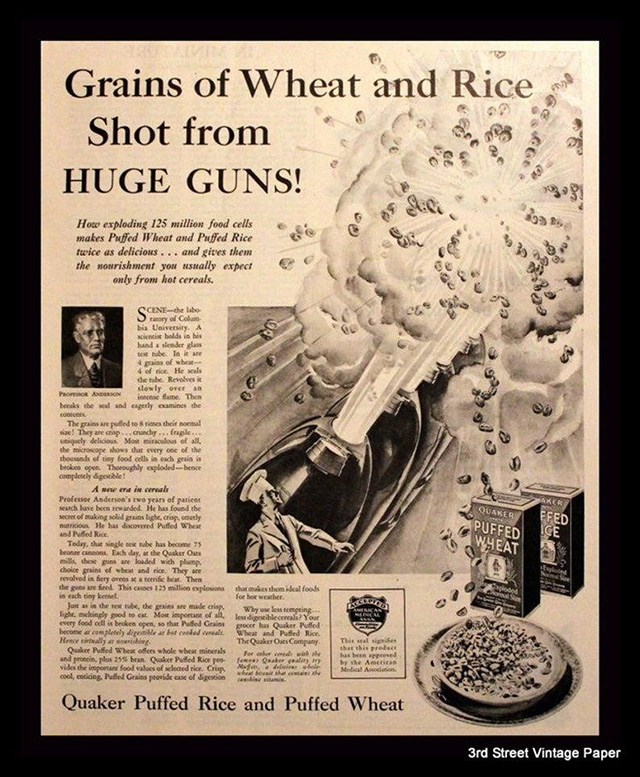
Pictures showing a real puffing gun are difficult to find, but it is safe to say that the puffing guns were nothing like real guns, especially considering that their twenty-inch cylinders would look more like a cannon than a gun barrel. In promotional pictures, the puffing guns were often depicted as cannons. Quaker even had an animated commercial that showed a kid climbing inside a small cannon that was meant to represent a puffing gun, and, bang, the kid came flying out of the cannon with one hand holding a box of Quaker Puffed Rice and the other a Quaker Puffed Wheat.[3]
Breakfast cereals had been invented about four decades before the advent of puffing guns, but Anderson’s invention drastically changed the industry and reshaped public perceptions on what cereal should be like. The puffing guns were only made for industrial use, as they were too big for hawkers and street vendors to carry around. An important manufacturer of puffing guns was Puritan Manufacturing Inc., which was founded in Omaha, Nebraska in 1927. In fact, Puritan’s founder patented a grain puffing machine that operated similarly to Anderson’s puffing gun. In 2013, New York City’s Summer Street Festival displayed a custom-made puffing gun, bringing back this bygone machine to show the public.[4]
According to an article in The New Yorker, puffing guns met their untimely demise in the U.S. after the Second World War as the newly invented continuous puffing machine made its debut (only in some Latin American countries, like Mexico and Peru, were Puritan’s puffing guns still widely in use for the industrial production of popcorn). However, though this marked the end of puffing guns in America, the machine took an unexpected journey to East Asia, and went on to flourish for nearly half a century more.
Pongashi ki: A Japanese Invention
The puffing gun that emerged in East Asia was a smaller portable model that could easily be operated by a single man. It is unclear as to when and through what route was the puffing gun introduced to East Asia, but the invention and spread of potable puffing machines in Japan are attributable to a woman called Yoshimura Toshiko (吉村利子). Yoshimura worked as a primary school teacher in Osaka during the 1940s. This was when ordinary people in Japan faced a severe food shortage in the aftermath of the Second World War; many kids suffered from malnutrition, digestive distress, and diarrhea. Deeply worried about these children’s wellbeing, Yoshimura attempted to devise an idea to provide them with nutritious and easy-to-digest snacks.
With the help of his brother, who studied engineering at Kyoto University, Yoshimura worked out the design of a puffing machine. However, to make a prototype, she needed to find a source of iron, which was controlled by the military government during the war, and good craftsmen. One of her college teachers told her that she might be able to find a supply of iron from Yahata in Fukuoka prefecture. Yahata was a city famous for its steel industry, thus becoming a major target of air strikes for the Allied Forces. Despite the danger, Yoshimura traveled there in the summer of 1944, and finally succeeded in making a first prototype in early 1945 (the war ended later in the same year). Yoshimura founded a company to manufacture her puffing machines, which soon gained popularity across the country.
Yoshimura might be credited for proliferating puffing machines in Japan, but puffing machines had already existed in Japan before she made her prototype. In fact, Yoshimura recalled seeing back in 1928 a piece of machinery that made snacks with a bang; she was only four years old and was frightened by “that dark monster.” It was not until when she was 17 and studying in college that she found out that the monster was a “grain puffing machine,” and the Germans used to make these machines from damaged cannons during the First World War. The source of this information could not be ascertained, but, considering Germany’s leading role in introducing modern science and technology to Japan, it is a reasonable assumption that the puffing machine had also been brought to Japan through the same route.
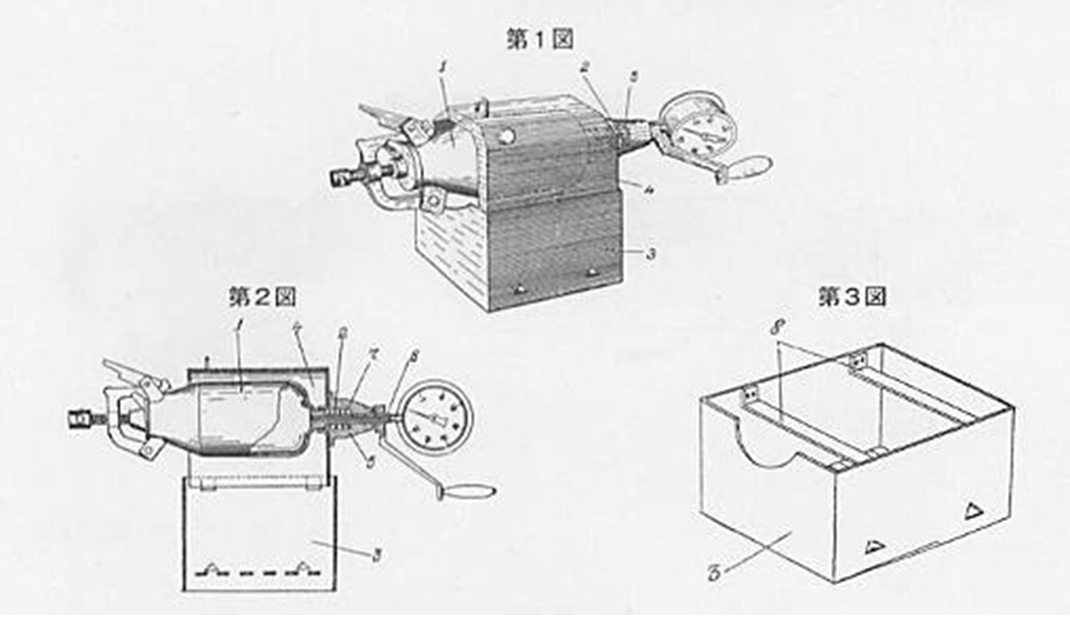
Yoshimura gave the puffing machine a simple name — ponkashi ki (ポン菓子機), which literally translates into a “snack-making machine with a ‘bang’.” The “pon” referred to the boom that it would make when unlidded. The machine had another, more generally accepted name, kokurui bouchou ki (穀類膨張機, “grain puffing machine”), and it targeted a different clientele than its American counterpart: the American puffing machine was designed for the mass production of breakfast cereals; the Japanese ponkashi ki, on the other hand, was designed to be easy to operate by individual vendors and carried around to rural, even mountainous places, which was in line with Yoshimura’s original intention — she had not wished to introduce a new staple food or breakfast option to Japanese families; instead, the pongashi produced by her machine was meant to be served as a snack for Japanese children.
The Puffing Machine Goes to East Asia
From the late 19th century to the 1940s, Korea and Taiwan were colonies of the Japanese Empire. Moreover, during the Second World War, Manchuria and the majority of the northern and eastern coastal provinces of China were under Japanese occupation. It is therefore natural to assume that the potable puffing machine was introduced from Japan into South Korea, Taiwan, and mainland China.
In South Korea, the machine took on the name ppeong twigi (뻥튀기), which, like its Japanese name, also contained an onomatopoeia of its explosive sound. In mainland China, the machine was most popularly known as a baomihua ji (爆米花机), which translated into “a machine for making popped rice flowers.” This name gradually became synonymous with popcorn machines in contemporary China. In Taiwan, the machine had a longer name — baomixiang yaliguo (爆米香壓力鍋), in other words, a pressure cooker for popping aromatic rice.
East Asia is one of the world’s most important rice growing and consuming regions, and so it is not surprising that the first puffing machines in East Asia were predominantly used on rice instead of corn. In fact, puffed rice had long been consumed before the advent of these puffing machines. In China, eating puffed rice had been a delicacy of the Jiangnan region since as early as the 11th century, and the traditional way to make it was to use big woks to heat up the rice (or other grains such as millet and soybeans).
However, the assumption that puffing machines merely arrived in the rest of East Asia from Japan remains unverified. In fact, the origin of puffing machines in China used to be a real mystery — no one there could tell in which exact year the machines first appeared. Moreover, considering the fact that puffing machines began to proliferate and gain popularity in Korea, China, and Taiwan after the end of the Japanese occupation, then one must ask: how was Yoshimura’s ponkashi ki actually introduced to these areas? Was it ever actually introduced?
A set of photographs taken in 1938 by a Scottish missionary couple by the names Ian and Rachel Morrison have made the question more puzzling. During a vacation in Beidaihe (北戴河, a famous summer resort in northern China located on the coast of Bohai Sea), the Morrisons took several pictures. Among them were three sequential pictures that showed a man (and a child) using a portable puffing machine to make puffed rice, and the machine was very similar to the model we see in contemporary China.
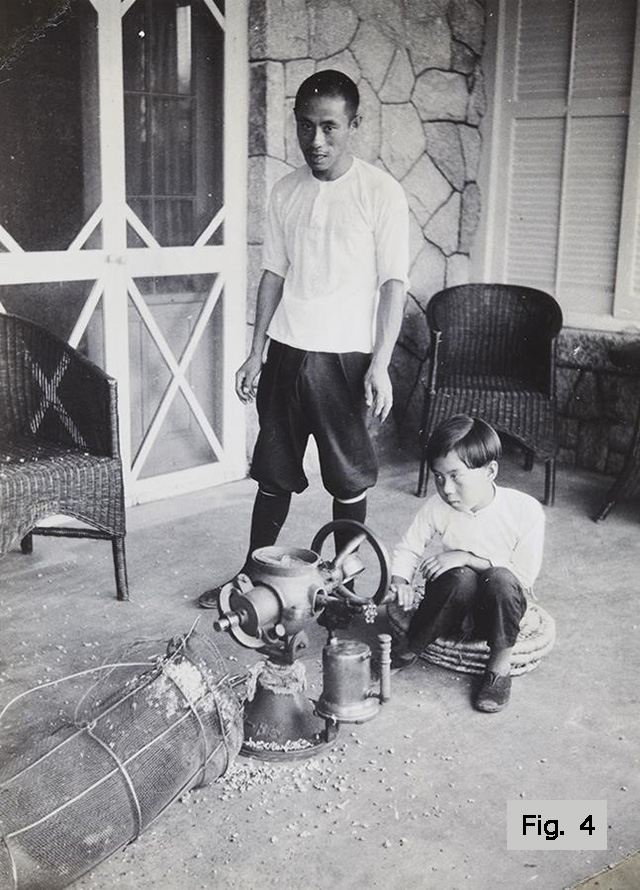

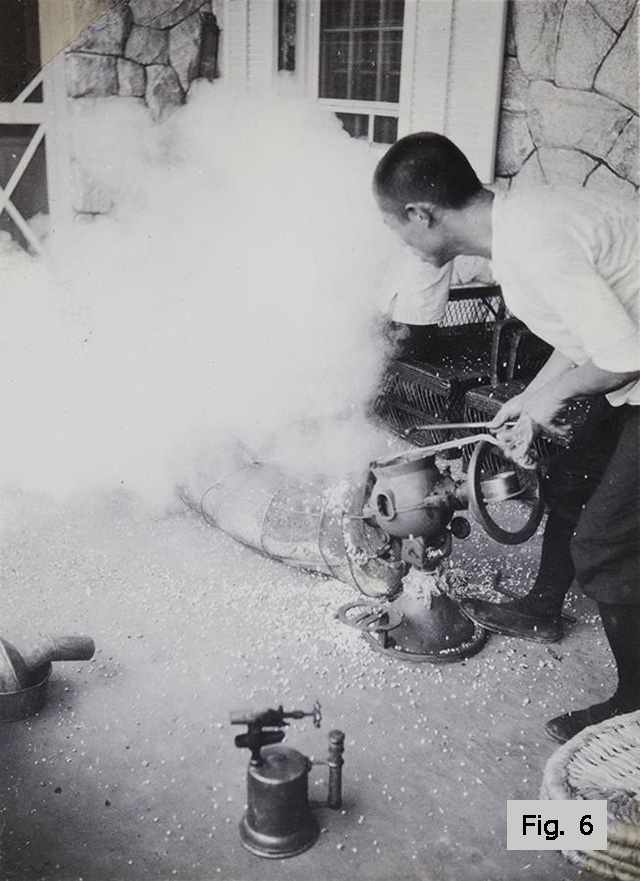
Fig. 4-6 The Morrisons’ photographs of a man (and a child) using a puffing machine in Beidaihe in 1938. Source: Ian and Rachel Morrison Collection, Mo04-121, Mo04-122, Mo04123, courtesy of Neil Morrison and the “Historical Photographs of China” project, University of Bristol: www.hpcbristol.net).
In another collection of photographs taken in China during the Second World War, compiled in 2016 by a Chinese scholar, a similar puffing machine appears. The particular picture was taken in 1945 in the wartime auxiliary capital of China, Chongqing. An American officer, accompanied by the director of the military supply factory, was examining army rations (presumably puffed rice), and a puffing machine lay quietly beside them.
What the photos indicate is that the portable puffing machine had been introduced to China before Yoshimura designed her prototype. The two machines shown in the two sets of photos look similar, but both differ from Yoshimura’s model. The origin of the puffing machine in Morrison’s photo is unclear, but what is certain is that both puffing machines and puffed foods were rarities in China at the time. Judging from the house and the attire of the child, it could be conjectured that this was a well-to-do family. At the time, Beidaihe was not unfamiliar with exotic foods and machines, since the Qing ruler had opened it to foreigners in 1898. However, because Beidaihe was under Japanese control in 1938, the possibility that the machine had come from Japan could not be ruled out entirely.
The puffing machine first appeared in South Korea around the 1950s. In the Jung District of Busan, South Korea’s busiest port city, there is a historic stairway called the “40-step Culture and Tourism Theme Street.” During the Korean War, Busan used to be flooded with refugees, and this stairway once served as a point of rendezvous for separated families. Now, several bronze figures line the street, representing the lives of those refugees of the 1950s. Among the figures is one that depicts a man operating a puffing machine. Puffed rice used to be the relief food for these refugees as puffing was a quick way to cook rice. As the grains of rice each expanded to ten times its original volume, they could satiate that many more people.
The U.S. might have been responsible for bringing the puffing machine to South Korea and to China. In the aforementioned picture taken in Chongqing, there is a U.S. officer who appears beside a puffing machine, prompting us to ask: could it be possible that the puffing machines in South Korea and China during the 1940–1950s had actually come from the U.S.? We have no direct proof of this, but what can be deduced is that puffing was a significant technology in making military rations — most wartime foodstuffs supplied to the military were dehydrated and compressed into smaller volumes. Unlike in the U.S. forces, who had a supply of various cereals, bread, and canned meat from the domestic food industry, in East Asia’s military forces, puffing technology became a crucial way to process rice and other grains before packing them into small bricks. It is therefore very likely that the spread of this technology could be ascribed to the manufacture of military rations during the Second World War.
It is also evidenced by their design that the puffing machines that showed up in other East Asian countries were not directly modeled after Yoshimura’s ponkashi ki. First, Yoshimura’s ponkashi ki had a steel cover on a gourd-shaped body and a box that served as the base for the whole machine, inside which the stove was located. These two parts did not exist in the models in South Korea, Taiwan, and mainland China. Second, the two models’ buckle systems differed. For Yoshimura’s model, the lid of the cooker was lifted by hitting a lever on the buckle with a hammer toward the front of the machine. For the other models, one would use a metal tube to extend the lever on the buckle, then pull it toward the back of the machine.
Attached here are four YouTube videos of the respective popcorn/puffed rice making processes in contemporary South Korea, mainland China, Taiwan, and Japan. In each video, note how the lid is sealed and opened:
South Korea:
Source: YouTube, https://www.youtube.com/watch?v=O5yyEUcmpVk
The Mainland China:
Source: YouTube, https://www.youtube.com/watch?v=xkG_CxIttj8
Taiwan:
Source: YouTube, https://www.youtube.com/watch?v=KoCYGV8TCT8
Japan:
Source: YouTube, https://www.youtube.com/watch?v=dzI4IXFBsgU
Arriving in China
Even though portable puffing machines had already existed in China in the 1930s–1940s, it was unlikely that they continued to be used after the CCP took over the mainland. Presumably, the KMT government and military forces took the technology with them to Taiwan, which contributed to its later popularity there. In Taiwan, people would add syrup (and sometimes nuts) to the puffed rice, then shape the mixture into candy bars. The question remains: when and why was there a renaissance of puffing machines in mainland China, so much so that their popularity and prominence have given people the misconception that it was invented by the Chinese?
A popular story circulated in China about the indigeneity of puffing machines. Legend has it that former U.S. President Richard Nixon did not know about puffing machines until he visited China in 1972 and saw a street hawker operating one. Nixon asked then Chinese Prime Minister Zhou Enlai about this “strange machine” that yelped out a boom every now and then. The ever witty Zhou told Nixon that it was a “rice puffing machine.” Apparently impressed, Nixon exclaimed, “No wonder China no longer has a food shortage, since you have invented such an amazing machine!” The point of the story was as much to poke fun at Nixon as it was to show Zhou in a good light — that somehow his quick-witted answer gave Nixon the impression that not only was the machine not the mundane, backward piece of metal that it in fact was — far from it — it represented China’s tremendous technological progress. This story, needless to say, was a fabrication, but it reinforce the notion that puffing machines were a Chinese invention.
In truth, however, it was not until the 1980s that portable puffing machines reappeared in mainland China, but this time around, it was not only for the military or well-to-do households; it showed up in rural markets and urban residential areas. Hawkers carried the machines around on bicycles or pedicabs, then set them up on the roadside, and everywhere these dark cannons would shoot popcorn or puffed (into bags) and disseminate excitement. Children were drawn to the machines, stealing curious peeks, watching on with both expectation and apprehension.
Hawkers and street peddlers were very common in 1980s and 1990s China at the started of its reform era. At that time, grocery stores, wet markets, and restaurants were still scare in the urban areas, and hawkers supplied most everyday foodstuffs and services to the urban dwellers. Different kinds of hawkers each developed their own ways of peddling. Some belted out rhythmic chants; others knock objects together to make noise. The big boom would herald the imminence of popcorn/puffed rice.
The to-be-puffed rice was not provided by the hawkers though — it was the customers’ responsibility to bring it (or corn), and the small cost collected by the hawker for operating the machine (usually less than 1 yuan for one serving). Some hawkers added sweetener — not sugar, but the much cheaper substitute saccharin — to enhance the flavor. Popcorn turned out to be more popular than puffed rice, as, first of all, corn was cheaper than refined rice, and, until the PRC put an end to the grain rationing system in 1993, most people would not be willing to give up what limited rice reserve they had just for something that was somewhat perceived as a snack for children.
As China gradually opened up in the early 1980s, several puffing snacks from abroad were introduced to the big cities. It also stimulated the Chinese food industry to devise its own puffing machines. While the leading research institutions of food technology and industries were devoted to designing large puffing machines for mass industrial productions, small rural industries turned to manufacturing portable puffing machines for the low-end markets, and it was likely that these new portable puffing machines were modeled after the designs that were already popular in Taiwan and South Korea.
While portable puffing machines flourished in 1980s mainland China, puffing machines had already started to decline in Japan, South Korea, and Taiwan. In the 21st century, China’s rapid economic development has also brought more food and snack choices to ordinary people. Even though the Chinese people no longer need to worry about the supply of rice and corn, the popcorn and puffed rice made by old-fashioned machines have no way of competing with various new mass-produced products. Portable puffing machines have lost favor with the people. They continue to be found in odd places, but wherever they appear, they would only evoke nostalgia in the generation of Chinese people who grew up with them during the 1980s and 1990s.
The itinerary of puffing machines shows how a technology was transformed and adapted in and by different social and cultural milieux. Large puffing machines are still used in the U.S. food industry, and old-styled puffing guns are still present in some Latin American countries. In India, the traditional food murmura — which is puffed rice that used to be made in a big wok — is now also made using continuous puffing machines, which however do not produce the same boom that was signature of the other older East Asian models mentioned above. Moreover, it was only in East Asian countries that puffing machines were made portable for street hawkers.
In the end, the mechanism of puffing has been unveiled from the technological black box that it was once encased in, and has reverted to being a public spectacle, much like it (i.e., early puffing guns) once was in the U.S — not only did the food but also the curious technology that made puffed foods a favorite among the populace. Now, this spectacle seems to be confined only to East Asia, where most people find it surprising that the machine has originated from all the way across the Pacific Ocean.
Footnotes
- See the particular episode here: https://youtu.be/baQT0pwvXKQ.
- For a short video produced in the 1950s on Quaker’s puffed rice, see https://youtu.be/_bn1IYlKiZk.
- See the animation here: https://youtu.be/zGpS6LHeBC0.
- See https://www.mofad.org/boom/.
References
- De Salcedo, Anastacia Marx. Combat-Ready Kitchen: How the U.S. Military Shapes the Way You Eat. New York: Penguin Random House, 2015.
- Dylan-Robbins, Sky and Matt Buchanan. “Puffed: The Magic of Cereal.” The New Yorker, August 13, 2013. https://www.newyorker.com/tech/annals-oftechnology/puffed-the-magic-of-cereal
- Robbett, Mary Kate. “Alexander Anderson and the Cereal Shot from Guns.” Lemelson Center for the Study of Invention and Innovation, Smithsonian National Museum of American History. https://invention.si.edu/alexander-anderson-andcereal-shot-guns
- Sinon, Stephen. “Celebrate Archives Month with Alexander P. Anderson’s ‘Eighth Wonder of the World’.” New York Botanical Garden. https://www.nybg.org/blogs/science-talk/2019/10/celebrate-archives-month-withalexander-p-andersons-eighth-wonder-of-the-world/
- Smith, Andrew F. Popped Culture: A Social History of Popcorn in America. Columbia, SC: University of South Carolina Press, 1999.
- Wada Toshihiro. “Pongashi to ponkashi ki oyobi ehime keno ponkashi no shokubunka” ポン菓子とポン菓子機および愛媛県のポン菓子の食文化 [Puffed snacks, puffing machine and pongashi culture in Ehime], in Ehime daigaku houbungakubu ronshuu 愛媛大学法文学部論集 [Essay collection of Faculty of Law and Letters, Ehime University], vol. 29, 1–43. Matsuyama: Essay collection of Faculty of Law and Letters, Ehime University, 2010.
- Wada Toshihiro. “Pongashi no kigen to bei kan chū dai oyobi ehime keno pon kasha no shokubunka” ポン菓子の起源と米・韓・中・台および愛媛県のポン菓子の食文化 [The origin of puffed rice and pongashi culture in the U.S., Korea, China, Taiwan and Ehime Prefecture], in Ehime daigaku houbungakubu ronshuu 愛媛大学法文学部論集 [Essay collection of Faculty of Law and Letters, Ehime University] vol. 33, 1–56. Matsuyama: Essay collection of Faculty of Law and Letters, Ehime University, 2012.
- Zhang Haixing 张海星 (eds.). Erzhan jishi yingxiang tudian: zhongguo juan 二战纪实影像图典·中国卷 (World War II documentary photographs, volume on China). Chongqing: Chongqing press, 2016.
